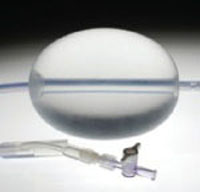Every obstetrician fears the day when one of her (or his) patients has a massive postpartum hemorrhage. For good reason, we endeavor continuously to improve our ability to respond to this obstetric emergency (TABLE): Postpartum hemorrhage is a major cause of pregnancy-related death in both developed and developing nations.
One of those improvements in care is the Bakri balloon (Bakri Postpartum Balloon, Cook Medical) (FIGURE), which, I believe, is one of the most important recent advances for treating serious postpartum hemorrhage. I’ll explain here why this device should be utilized more often when treatment with a uterotonic hasn’t adequately resolved bleeding.
TABLE
At your disposal, a range of interventions for postpartum hemorrhage
| Pharmacotherapy | ||
| Carboprost Methergine | Misoprostol Oxytocin | Vasopressin |
| Blood banking | ||
| Cryoprecipitate Fresh-frozen plasma | Platelets | Red blood cells |
| Surgery | ||
| Repair of lacerations B-Lynch suture Hysterectomy, supracervical Hysterectomy, total | Ligation of the hypogastric artery Other uterine compression sutures | Pelvic packing Pelvic tourniquet |
| Nonsurgical procedures | ||
| Bakri Postpartum Balloon | Uterine balloon tamponade | Uterine packing |
| Interventional radiology | ||
| Uterine artery balloons | Uterine embolization | |
| Consultation | ||
| Anesthesiologist–intensivist Gynecologic oncologist | Interventional radiologist Trauma surgeon | Urologist |

FIGURE Bakri Postpartum Balloon
SOURCE: COOK MEDICAL, INC. USED WITH PERMISSION.
How, and how well, the Bakri balloon works
The Bakri balloon is a 24-French, 54-cm long, silicone catheter that contains a large central lumen and a 500-mL balloon that can be inflated once the device is inserted in the uterus. Downward traction on the balloon helps to ensure that the surface of the balloon is tightly opposed to the lining of the lower uterine segment. The catheter provides temporary reduction of postpartum uterine bleeding if management with uterotonics, repair of genital lacerations, and removal of retained placental tissue has been unsuccessful.
The literature on the use of the Bakri balloon comprises case reports and case series.
Bakri’s first report described how he placed—simultaneously—10 (or more) standard Foley balloons in the lower uterine cavity to control postpartum hemorrhage.1 Building on this success, he and his team later developed a single, large balloon with a large central lumen and used it successfully in women experiencing postpartum hemorrhage.
In an initial case-series report, the single balloon was used to treat postpartum hemorrhage in women with placenta previa or low-lying placenta and a suspicion of placental accreta.2 Two subjects had placenta previa and a history of, in one case, three and, in the other, five prior cesarean deliveries—putting them both at greatly increased risk of placenta accreta. The Bakri balloon was placed at the time of cesarean delivery for those two women.
“How” in cesarean delivery. When the balloon is placed at the time of cesarean delivery, an assistant working from below helps pull the distal end of the balloon shaft through the cervix into the vagina. Next:
- The hysterotomy incision is closed
- A vaginal pack is placed to keep the balloon seated in the uterus
- The balloon is filled with 250 to 500 mL of sterile isotonic fluid
- The distal end of the balloon is attached to a weight, such as a liter intravenous fluid bag, to ensure that a tamponade effect is maintained.
- A Foley catheter is inserted in the bladder to monitor urine output and reduce bladder volume
- The uterus is examined to ensure that there are no retained placental fragments
- The balloon is inserted into the uterus so that the entire balloon is past the internal cervical os; ultrasonographic guidance can help determine proper placement
- Using a syringe, the balloon is filled with sterile saline to the desired volume—again, typically, 250 to 500 mL
- Gentle downward traction is placed on the balloon stem to ensure that a tamponade effect is maintained
- A balloon that protrudes through the cervix can be deflated, repositioned, and reinflated
- Vaginal packing may be useful to help keep the balloon within the lower uterine segment
- The drainage port of the balloon is connected to a fluid collection bag to monitor uterine bleeding; the drainage port and tubing can, if necessary, be flushed with sterile saline to ensure patency and prevent clots from obstructing the drainage port
- The balloon is kept inflated for 12 to 24 hours—the maximum indwell.
Most clinicians administer an antibiotic until the balloon is removed. When the decision is made to remove the balloon, it can be deflated 1) all at once or 2) in two or three stages, with attention to the onset of new bleeding. An alternative approach, such as exploratory laparotomy or interventional radiology (IR), is indicated if a patient continues to bleed after the balloon is placed.
Advantages. The Bakri balloon is easily placed and removed. Its silicone composition reduces the chances that the balloon will “stick” to the uterine lining. The large central port provides real-time assessment of the effectiveness of balloon tamponade. This property of the device allows it to be used in a diagnostic manner—the so-called tamponade test.


